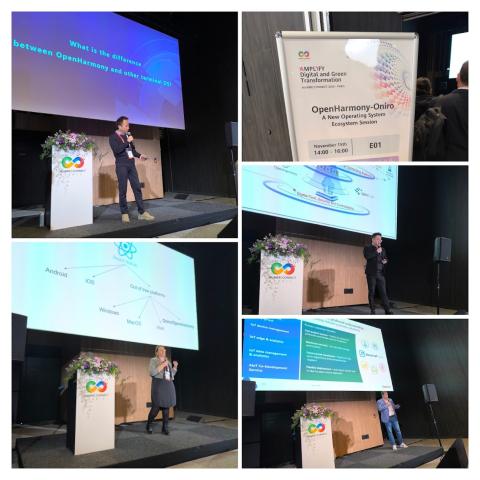The recent Oniro and OpenHarmony event brought together key stakeholders from the open-source community, showcasing the power of collaboration between the Eclipse Foundation Oniro and the OpenAtom Foundation OpenHarmony. With a lineup of insightful talks and deep dives into emerging technologies, the event was a testament to the growing synergy between the two projects. Here's a recap of the key moments and takeaways:
Welcome and introduction
Adrian O’Sullivan director at Huawei OSPO kicked off the event with a warm welcome, emphasizing the significance of having the Oniro and OpenHarmony communities meet face-to-face once again. He outlined the agenda, highlighting the opportunities for collaboration and the exchange of innovative ideas.
Gaël Blondelle, CMO at the Eclipse Foundation, reflected on the journey of Oniro, which officially launched in 2021. He noted the key milestones, particularly the November 2023 collaboration agreement with the OpenAtom Foundation. This agreement is paving the way for a European counterpart to OpenHarmony's success in China, further strengthening the partnership between the two communities.
Exploring the Oniro and OpenHarmony Collaboration
Juan Rico provided an in-depth look at the partnership between the Eclipse Foundation and OpenAtom Foundation, focusing on the impact of their collaboration on the smart device industry. He emphasized that the cooperation agreement is not just a high-level document but a roadmap with actionable steps. The goal is to build a global open-source ecosystem that benefits consumers, developers, and device manufacturers alike.
The Power of OpenHarmony
Ren Gelin Chair of the OpenHarmony PMC delivered a technical deep dive into OpenHarmony, exploring what sets it apart from other operating systems. With its "develop once, run everywhere" philosophy, OpenHarmony enables seamless user experiences across multiple devices—from smart TVs and tablets to smart speakers and kitchen appliances. Gelin introduced the concept of the Super Device, where multiple devices operate under a unified OS, allowing for intuitive cross-device interactions. The release of OpenHarmony 5.0, with its 400+ integrated libraries (including React Native), reflects the project's rapid progress.
Transforming App Development with Open Source
The next session, led by Diego Zuloaga and Saurabh Goyal from Futurewei, tackled the challenges of app development, particularly around consistent user experience and cross-platform support. They introduced the Open Mobile Hub project, whose architecture enables cross-platform compatibility. By using wrappers and SDKs, they aim to bring a seamless experience to developers working with various platforms.
Bringing React Native to Oniro and OpenHarmony
Magdalena Retman-Rakoczy VP at Software Mansion shared insights on how React Native is being integrated into the Oniro and OpenHarmony ecosystems. Highlighting the strength of the React Native community, she demonstrated how the technology serves as a magnet for developers, leveraging a familiar framework to drive adoption. Software Mansion has already contributed significant libraries, paving the way for more robust app development on both platforms.
Industry Solutions and Use Cases
Dr. Yang Liu, VP at Hoperun. Hoperun is a co-founder of OpenHarmony and openEuler, shared inspiring use cases from different Special Interest Groups (SIGs). He highlighted the growing ecosystem around Oniro Kit, which is now in the process of being available to the community. His presentation underscored the opportunities within the consumer electronics market, leveraging HarmonyOS’s impressive adoption figures.
Managing IoT Devices with Eclipse Kanto
The final talk by Kai Hackbarth, Head of Products and Solutions Europe at Bosch Software and Digital Solutions focused on managing IoT devices using Eclipse Kanto. As a lightweight, containerized agent that can run on embedded devices, Eclipse Kanto offers solutions for device management, edge analytics, and software updates. This tool is essential for ensuring compliance with the Cyber Resilience Act (CRA) while supporting a global ecosystem of connected devices. Hackbarth also discussed the potential of local digital twins in optimizing IoT solutions.
Key Takeaways
The event highlighted the strength of collaboration between the Oniro and OpenHarmony communities. By working together, these projects are poised to redefine the smart device landscape, fostering innovation and creating a truly global open-source ecosystem. The future looks bright as both communities continue to break new ground in technology and open-source collaboration.
Stay tuned for more updates as the Oniro and OpenHarmony projects evolve, bringing even more exciting opportunities for developers and the tech community worldwide.

